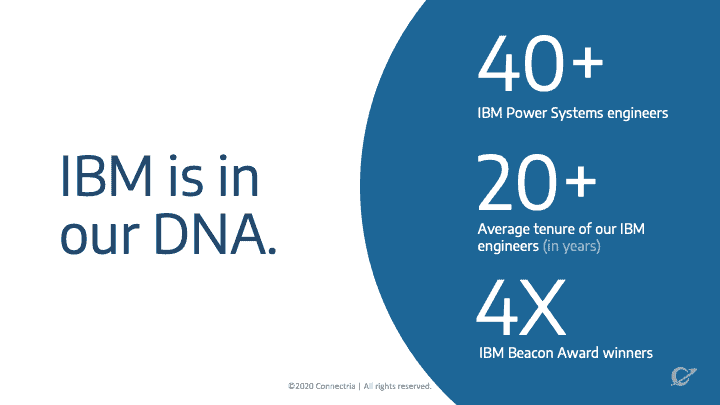End of the Road: 3 Decision Points in the Life of Your IBM Power Systems Infrastructure
Connectria
Author
Date
July 22, 2020

The IBM Power Systems platform has been a mainstay in IT departments around the world for decades. While this longevity offers stability for users, it’s not without some drawbacks. Namely, nothing lasts forever, so some elements of your IBM infrastructure will eventually need to be replaced. In this article, we’ll look at three decision points in the life of your IBM systems. Below we’ll offer ideas to help you choose the right path forward.
Challenge #1: System Admin Retirement
According to BLS statistics, the average retirement age in the U.S. is right around 61. Discussing future retirement with a veteran employee can be awkward. However, without this conversation, your team, and systems, are left in a precarious position. Your IBM Sys Admin is responsible for ensuring the performance and reliability of the organization’s mission-critical systems. Even if a retiring IBM Sys Admin gives several weeks’ notice, they’re not easy to replace. Therefore, it’s imperative to encourage open and honest communication with your senior team leaders to best prepare your teams for the inevitable.
Some IT departments may also see the effects of COVID-19 influencing retirement decisions. Adults who might have otherwise delayed retirement may decide not to take their chances, especially those with underlying conditions. While many employers want their workers to make the right decision that benefits their circumstances, your organization can be left in a bind when the one retiring is your IBM System Administrator.
Finding a replacement with the right expertise is challenging enough as fewer people learn about Power Systems. It’s also nearly impossible in rural communities. For a while, Red Gold Tomatoes, located in rural Indiana, tried spreading out IBM Sys Admin duties to several staff employees, but none of them had the level of IBM experience needed for such a critical role. Eventually, they called on Connectria’s Remote Monitoring and Management Services to help them fill in the skills gaps.
Challenge #2: Legacy Applications
One of the advantages of IBM Power Systems infrastructure is that legacy applications built for older models can often run on newer Power Systems hardware without significant modification. While this allows the enterprise to put off reinvesting in mission-critical functions, it also means that the applications in use might be 10 to 20 years old – or more.
Some organizations will continue to use these systems long after the vendor has stopped upgrading and supporting them. This is risky since hackers will often develop exploits specific to these systems, especially if they still have a broad installed base of users. Eventually, even the most traditional organization acknowledges they’re falling behind their competitors, thanks to obsolete business solutions.
If you’re relying on legacy applications that have reached the end, you now have a decision to make. Do you continue to leverage the IBM platform or is it time to look at re-platforming the business function?
This decision needs to be made in the unique context of your business, so there isn’t a universal “right answer.” According to Help System’s 2020 IBM i Marketplace Survey, 22 percent of IBM i Power Systems users planned to migrate all or some of their applications to a new platform, e.g., Linux, Windows, or SaaS. A plurality (45 percent) planned to remain on the IBM i platform.
Challenge #3: Hardware End of Life
IBM users are accustomed to IBM extending server on older hardware far longer than other platform vendors do. Alas, all good things must come to an end. IBM has announced that it will be discontinuing lease, rental, and maintenance services for Power7 hardware at the end of 2020.
Since the status quo is not an option (at least not for the IT security-conscious organization), this scenario leaves you with another choice to make. Do you contract with third-party maintenance (TPM) organization that can help you get a few more years out of your hardware – for a price? Or do you bite the bullet and upgrade to Power9 hardware? Or maybe you meet somewhere in the middle, contracting with a TPM organization for now so you can upgrade to Power10 systems whenever they are released. (current ETA: 2021)
Our opinion: There are definite advantages to upgrading to newer IBM hardware. Security and performance are certainly at the top of the list, but there are other advantages as well. For example, Connectria decreased data center energy consumption by 95 percent. Hardware upgrades allowed us to serve even more customers while reducing the number of servers required.
One way to enjoy the advantages of the latest hardware and reduce your overhead costs is to migrate your IBM workloads to the cloud. These days, IBM and even AWS offer cloud options for IBM customers looking to migrate workloads to the cloud. However, if you’re facing the first two challenges above, a private hosted IBM cloud might be a more secure option.
Connectria and IBM
Connectria has offered IBM hosting and management services for more than 20 years. We also host more IBM i workloads than any private hosting provider worldwide – other than IBM itself. This allows us to hire and retain the best IBM Sys Admins in the business as well as maintain a regular hardware refresh cycle shorter than most other providers.
Earlier this year, Connectria was awarded a 2020 IBM Business Unit Excellence Award at IBM Think 2020. These awards recognize the stellar performance of IBM Business Partners who have demonstrated excellence and drive exceptional client experiences and business growth.
You can learn more about Connectria’s IBM managed hosting and IBM remote management services here. When you’re ready, reach out to us for a personalized consultation. Our experts can help you continue to leverage the IBM Power Systems platform for many years to come.
Topics
Keep Reading
Prepare for the future
Tell us about your current environment and we’ll show you the best path forward.
Fast track your project. Give us a call.







